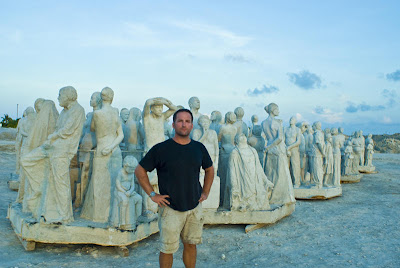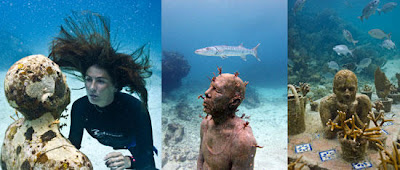The first 200 sculptures are ready to be deployed in the new Museum of Underwater Art in Cancun, Mexico. Created by Jason deCaires Taylor, the sculptures will form a monumental artificial reef, designed to promote marine life, increase bio-diversity and draw Cancun visitors away from existing reef habitats.

Jason deCaires Taylor & Museo Subaquático de Arte (MUSA)
Creator of the worldʼs first underwater sculpture park, Jason deCaires Taylor (read our interview here) has gained international recognition for his unique work. He has now embarked on his most ambitious project to date, to create a monumental underwater art museum in The National Marine Park of Cancun, Mexico.
The project will consist of more than 400 life size sculptures sited in clear shallow waters to afford easy access by divers, snorkelers and those in glass-bottomed boats.
Whilst exploring the intricate relationships between modern art and the environment, Taylorʼs underwater sculptures are designed to create artificial reefs for marine life to colonise and inhabit. His work engages with the possibilities of a sustainable future, portraying human intervention as both positive and affirmative.
The National Marine park of Cancun attracts over 750,000 visitors each year placing huge pressure on the existing natural reefs, Taylorʼs work aims to draw tourists away from the natural reefs allowing them and the species that in inhabit them to develop naturally.
Already the first three sculptures installed in November 2009 have been a great success, drawing much interest from tourists and showing immediate exponential coral growth. The locations were sited specifically within an area of the national marine park severely damaged by hurricanes and tropical storms, an ecosystem in need of regeneration.

Taylor is currently working with a team of local artists in Mexico on the production of 400 sculptures entitled The Silent Evolution. Two hundred figures that are now completed will be installed in June 2010 with of the second half of the figures in November 2010.
The monumental underwater museum is situated in the waters surrounding Cancun, Isla Mujeres and Punta Nizuc. The project, founded by Jaime Gonzalez Cano of The National Marine Park, Roberto Diaz of The Cancun Nautical Association and Jason deCaires Taylor, will eventually consist of over 400 permanent life-size sculptures as well as work by other local and international artists, becoming one of the largest and most ambitious underwater artificial attractions in the world.
The Cancun Marine Park is one of the most visited stretches of water on the planet and this places immense pressure on its resources. The Art of Conservation (El Arte de Conservacion) will be the museumʼs motto as it aims to demonstrate the interaction between art and environmental science. It will create a unique and dynamic underwater space that both celebrates the rich history of the region and highlights the role of art in promoting awareness of environmental issues. MUSA will be a progressive new artistic centre that will enhance the reputation of Cancun, an area severely lacking in contemporary cultural importance.
The Official inauguration of MUSA will be in December 2010.
Background Projects
In May 2006 Jason deCaires Taylor established the worldʼs first underwater sculpture park in Grenada, West Indies. Moilinere Bay is now home to sixty-five sculptures, covering an area of 800sq metres. The bay on the west coast of Grenada had suffered considerable storm damage over recent years,
notably with Hurricaneʼs Ivan and Emily in 2004 and 2005 and the placement of an artificial structure has provided a new base for marine life to proliferate. The sculptures were also designed to create a diversion from other areas of coral reef currently endangered by over use from water actvities.
The most recent images of Taylorʼs underwater sculptures, installed three years ago at Moilinere Bay, prove that the artistʼs claim to significantly encourage reef growth within the marine ecosystem is by no means merely a gimmick. It is this positive interaction with the natural world and in turn, this benefit to the environmental cause so key to our times, that puts Taylor in that rare sphere as an artist who can produce ground breaking art that also has a practical purpose.
Away from Caribbean waters, Taylor has also installed his work in rivers, quarries and on land. These sculptures engage with environmental issues particular to each ecosystem and show how his work can be pertinent to any location.

Artist Biography
Jason deCaires Taylor was born in 1974 to an English father and Guyanese mother, spending the earlier part of his life growing up in Europe, Asia and the Caribbean. Educated in South East England, he graduated in 1998 from Camberwell College of Arts, University of the Arts London, with a B.A.Honours in Sculpture and Ceramics. He is also a fully qualified diving instructor, underwater naturalist and award winning underwater photographer, with over 14 years of diving experience in various countries.
In May 2006 he gained international recognition for creating the worldʼs first underwater sculpture park in Grenada, West Indies. Drawing on the tradition of figurative imagery, the aim of Jason de Caires Taylorʼs work is to address a wide-ranging audience crucial for highlighting environmental issues beyond the confines of the art world. However, fundamental to understanding his work is that it embodies the hope and optimism of a regenerative,
transformative Nature.
The Environment
Cancun is Mexicoʼs largest tourist destination and the yearly quota of 750,000 people to the waters of the Marine Park not only provide a huge potential audience for MUSA but are in themselves at the heart of why Taylor was originally commissioned for this project.
Over the past few decades we have lost over 40% of our natural coral reefs. Scientists predict a permanent demise of 80% by 2050. Only about 10 – 15% of the seabed has a solid enough substratum to allow reefs to form naturally. In order to increase the number of reefs in these areas, artificial reefs have recently been created from materials that are durable, secure and
environmentally sensitive. These reefs attract coral growth, which in turn, can support an entire marine ecosystem.
One of the greatest benefits of artificial reefs is that they have lifted the pressure off natural reefs. Over the past few decades these reefs have been over-fished, over-visited and damaged by storms. By diverting attention to artificial reefs, natural reefs have now been given a greater chance to repair and to regenerate.
FAQ
Where are the three sculptures installed in the Cancun Marine Park in November 2009, located?
The Gardener of Hope was placed 4m deep in Punta Nisuc near the coast of Cancun.
Man on Fire was placed 8m deep in Manchones reef nearby to Isla Mujeres.
The Archive of Lost Dreams was placed 8m deep in Manchones reef nearby to Isla Mujeres.
The Silient Evolution (400 figures) will also be placed 8m deep behind Manchones reef.
The sculptures are located on sandy areas of substrate that do not cause harm to the existing ecosystems
How can we see the sculptures in the Cancun Marine Park?
All sculptures are easily accessible by diving, snorkeling and viewing from glass-bottomed boats. Cancun and Isla Mujeres have a vast number of tour operators working within the marine park. For trips visit: http://www.aquaworld.com.mx/
Where do you source the coral for placement within your sculptures?
The sculptures are propagated with live coral cuttings taken from areas of the reef system where coral has been damaged by storms or human activity. This technique, a well-established procedure in reef conservation, rescues damaged coral fragments by providing a suitable new substrate. A small proportion has also been artificially grown.
What materials do you use to build your sculptures?
A PH neutral-concrete (a mix of marine grade cement, sand and micro-silica), reinforced with special fibre-glass rebar. Some sculptures have additional elements such as ceramic tiles, glass and paper. 95% of the materials are inert.
Where do you get the ideas for your sculptures?
Various places, but quite often the idea for a sculpture can come at the most mundane moment, stuck in a traffic jam, washing up or whenever my mind is left to wander. I also like to walk and photograph imagining a world where our streets and houses are all 50m under the sea.
How long does the process of making a piece take?
After the initial idea I develop drawings and Marquetteʼs, photograph and overlay the image on the underwater site photo to see how it looks. A huge amount of research then goes into how the object will be secured to the ocean floor and what materials they will be constructed from. I cast the figures in my workshop and organize transportation to the site. Generally it is 3 months from start to finish.
How do you install the sculptures on site?
Depending on the weight and design of the sculptures most are deployed from a vessel with a lifting arm. Once in the water float bags are attached and the piece(s) can be carefully lifted and moved into the final position. Larger pieces are made in separate units and then connected underwater. Anchoring screws are used to connect the base of the piece to the
ocean substrate. The whole operation can take up to ten crew and five divers.
When did you first have the idea for an underwater museum?
I had the idea of an underwater sculpture park for over eight years and finally found an opening. The project in Grenada had the perfect location and support from the diving community and government.
How much money will the Mexico project cost?
The project has an initial budget of $350,000 (£210,000), with a significant proportion of the funding being provided by the Mexican government. The rest has been donated by individuals and organisations with an interest in promoting the area.
Quotes from Jason de CairesTaylor
“Over the last 20 years our generation has encountered rapid change both technologically, culturally and geographically. I feel this has left us with an underlying sense of loss. My work tries to record some of those moments”
“My sculptures arenʼt memorials. Theyʼre about the here and now. Thereʼs no ownership or possession”
“If this generation continues to live to its current values, by the time I am 75 we could have lost over 80% of our natural reef formations. How on earth can I justify that to my grandchildren”
"All my work is about change and forming objects that mirror the transient nature of our lives".
“Itʼs a stage, its environmental, an evolution, art intervention as growth, or a balancing of relationships.”
“Scientists are predicting at current rates of destruction we will loose 80% of our natural coral reefs by 2050, I hope my work goes some way to highlight this truly frightening hypothesis”
“Taking art off of the white walls of a gallery offers the viewer a sense of discovery and a sense of participation”.
"You can use sculpture as a way to convey hope, inspiring people to consider their interactions with the natural world and build a sustainable future"
“The experience of being underwater is vastly different from that of being on land. Objects appear twenty five percent larger underwater, and as a consequence they also appear closer. Colours alter as light is absorbed and reflected at different rates, with the depth of the water affecting this further. The light source in water is from the surface, this produces kaleidoscopic
effects governed by water movement, currents and turbulence. Water is a malleable medium in which to travel enabling the viewer to become active in their engagement with the work. The large number of angles and perspectives from which the sculptures can be viewed increase dramatically the unique experience of encountering the works.”
“By creating an artificial reef of sculptures, the ultimate aim of the project is to form a platform to promote the re-generation of marine life and use sculpture as a means of conveying hope and environmental awareness.”
For more information, please see:
All photos and information contained herein provided by Jason deCaires Taylor
